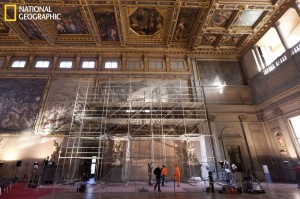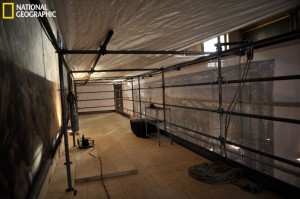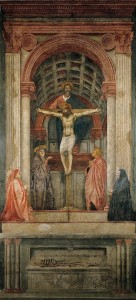 The search for the lost Leonardo da Vinci mural depicting the 1440 Battle of Anghiari in Florence’s Palazzo Vecchio has taken a disturbing turn. When last we saw art historian Maurizio Seracini, his team of graduate students from the University of California at San Diego and his videographic Boswell, National Geographic photographer Dave Yoder, they were raising money via Kickstarter to develop a gamma ray camera that would be able to capture an image behind the wall that currently features a battle scene painted by Giorgio Vasari in 1563. They were unable to reach their $265,000 fund-raising goal so the gamma ray camera is out.
The search for the lost Leonardo da Vinci mural depicting the 1440 Battle of Anghiari in Florence’s Palazzo Vecchio has taken a disturbing turn. When last we saw art historian Maurizio Seracini, his team of graduate students from the University of California at San Diego and his videographic Boswell, National Geographic photographer Dave Yoder, they were raising money via Kickstarter to develop a gamma ray camera that would be able to capture an image behind the wall that currently features a battle scene painted by Giorgio Vasari in 1563. They were unable to reach their $265,000 fund-raising goal so the gamma ray camera is out.
Instead, they will be drilling holes all the way through Vasari’s “Battle of Marciano” fresco so they can send fiber-optic cameras into the gap behind the wall and record images of anything that might be back there. Conservators have erected four stories of scaffolding in front of Vasari’s mural in the grand Salone de Cinquecento, the Hall of Five Hundred, of the Palazzo Vecchio, and drilled the first hole above the right kneecap of a soldier.
 The fiber-optic glimpse behind Vasari’s wall has confirmed what radar and sonar data suggested: that there is indeed a gap behind Vasari’s wall. It’s just a fraction of an inch deep, but sufficient to contain a painting. The team has collected samples from the entry points so even if cameras can’t see any pigment, tests on the drilled material might indicate if there was something painted on the wall Vasari bricked over.
The fiber-optic glimpse behind Vasari’s wall has confirmed what radar and sonar data suggested: that there is indeed a gap behind Vasari’s wall. It’s just a fraction of an inch deep, but sufficient to contain a painting. The team has collected samples from the entry points so even if cameras can’t see any pigment, tests on the drilled material might indicate if there was something painted on the wall Vasari bricked over.
Six more holes are scheduled to be drilled this week. Each drill spot has been approved by conservators from the Opificio delle Pietre Dure. They’ve chosen places that have already been damaged and are slated for restoration anyway or that are free of pigment, but not everyone was on board with the plan.
Cecilia Frosinini, mural paintings section director at Florence’s Opificio delle Pietre Dure art restoration laboratory, resigned in protest from the project.
“It’s an ethical question. I’m supposed to protect the artworks, and here there is an invasive intervention on the painting,” Frosinini wrote.
The lure of anything that might conceivably be a Leonardo, even a very, very long shot like this one, overrides the concern about invasive testing methods. We don’t know if there’s anything behind there at all. Vasari himself said that Leonardo’s painting never dried and ended up dripping away, and some art historians doubt that Vasari, who venerated Leonardo, would ever brick over his work and paint his own mural on top.
 On the other hand, there is precedent. Vasari was commissioned to paint over a 1425-6 Holy Trinity by Masaccio in the church of Santa Maria Novella. Vasari had acclaimed Masaccio in his Lives of the Artists as the best painter of his generation because of his realistic figures and adept use of linear perspective, which had been invented by architect Brunelleschi just a couple of years before in 1424.
On the other hand, there is precedent. Vasari was commissioned to paint over a 1425-6 Holy Trinity by Masaccio in the church of Santa Maria Novella. Vasari had acclaimed Masaccio in his Lives of the Artists as the best painter of his generation because of his realistic figures and adept use of linear perspective, which had been invented by architect Brunelleschi just a couple of years before in 1424.
The Holy Trinity in particular was a ground-breaking work that re-introduced Roman barrel vaulting to the visual arts before it had been re-introduced architecturally, and used one-point perspective to give the viewer the impression of looking into a deep niche. It inspired many great artists who followed him, including Michelangelo and Leonardo. Instead of painting directly on top of the masterpiece, Vasari built a brick wall in front of it and painted over the wall. Vasari’s wall was removed in 1861, revealing the Masaccio.
The results of the “Battle of Anghiari” drilling expedition won’t be known for several months.